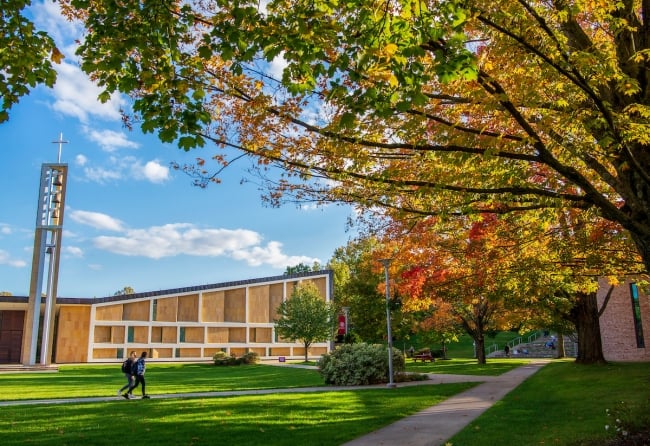You have /5 articles left.
Sign up for a free account or log in.

From President John Petillo’s office, he can see campus activity on the quad, which also includes the campus chapel.
Sacred Heart University
My office on campus overlooks the Chapel of Holy Spirit, whose presence graces the central quadrangle. On one of my hardest days as president of Sacred Heart University, at a vigil and service within, I mourned a recent student death with students, faculty and staff. The young woman had been killed in a car accident.
One student at the chapel that evening shared that he had not known the young victim.
“Then why are you at her service?” I asked.
“She was one of us,” he replied.
I was struck by the sentiment and its phrasing. For me, “one of us” has become a byword for presence—and the key to student success.
What Is Student Success?
Building a culture of “one of us” is difficult at an institution of more than 6,300 undergraduate students, but it is perhaps the most important thing we do.
College and university presidents hear the words “student success” regularly in senior staff meetings and throughout campus. But what does the term actually mean? I like to think of it as a job well done. Did we provide the programs and services on campus to help our students thrive? Did we guide and coach them to be critical thinkers so as to help shape their careers, develop their values and then watch them leave as successful graduates? Did our students feel they were not alone during their college journey?
If we can answer all of those questions in the affirmative, that’s student success.
There is little doubt that educational experiences suffered during the pandemic as we taught students virtually. The lesson that almost every college and university learned at that time is that undergraduates want—and, in many cases, need—the engagement of an on-campus experience.
Undergraduates Need to Be on Campus
I saw the sun shining bright on the chapel through my office window one recent morning when a campus visitor asked whether Sacred Heart University would ever consider fully remote options for undergraduate students. The vociferousness of my response surprised even me.
“Absolutely not,” I said. “Remote options may be fine for graduate students who want simply to obtain a credential and continue their career. You’re in, you’re out. But undergraduates going fully online flies in the face of the benefits of presence.”
It was a gut reaction, but one supported by ample evidence.
When asked about “meaningful ways to be involved on campus, feeling part of the college community and having a circle of friends at the institution,” students gave their institutions extraordinarily low marks in a recent white paper examining student success and the pandemic. There’s something to be said for midnight doughnut runs, participating in campus activities and traditions, and growing up together. It’s about engagement.
Numerous studies show the importance of spending time and institutional dollars on student success. Many schools have sophisticated tools to alert campus leaders when things are not going well. Recently, a working paper was published suggesting that student success coaches in North Carolina helped to increase retention by more than 22 percent at 11 community colleges. This, too, is about presence.
Presence benefits faculty as well as students. A couple of years ago, the National Bureau of Economic Research published a study showing that having a mentor helped female economists build lasting relationships, stay in academia and gain tenure at selective departments.
Presence, Then Persistence
College students typically drop out when they lack a sense of belonging; they don’t feel their presence on campus matters. How students integrate into our communities, build connections with each other and create a culture on campus can help predict whether they will stay and be successful. A campus community is a delicate ecosystem—one that depends on faculty, staff, administrators, students, alumni, invited guests and connections with the outside world.
I am not naïve enough to think that this is an “if you build it, they will come” moment. They may, in fact, come to our fields of dreams, but they will quickly leave if we do not consistently champion and demonstrate our values. Presence is merely the first step toward achieving student success goals. Persistence takes time, energy, financial resources and dedication.
Over the past several years, we have lived through a global pandemic, a highly divisive political climate and social unrest around racial inequities. One cannot plan for such societal forces that challenge our engagement on campus and our persistence as a community. However, I believe that if we work to help each student feel they are “one of us,” we will be able to journey and grow together.




